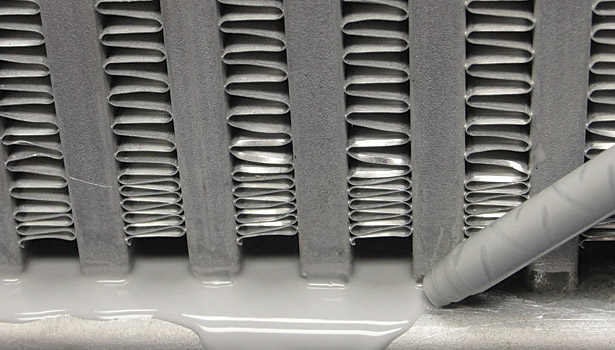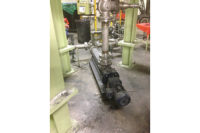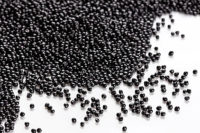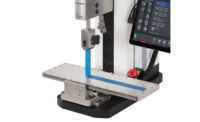In 2001, the trucking industry experienced some major problems when increased pollution controls raised under-hood temperatures and caused failures in big rigs, specifically in the tractor-trailers’ turbocharger systems. Without the extra boost from the turbochargers, these trucks had little power and were breaking down on roadsides all across the U.S.
The culprit turned out to be the charged air coolers (CAGs). Much like car radiators, CAGs are used to cool the turbo units. The CAG base has soldered fins that look and function exactly like automobile radiators, and these were leaking from micro-holes that were caused by displaced solder.
A means to quickly seal the CAGs was immediately needed to get the trucks back on the road. Because CAGs are constructed from a magnesium aluminum alloy with a zinc-rich surface coating, they presented a difficult substrate for bonding. The zinc easily flaked off and acted like a release agent, hindering any potential sealer.
MEETING THE CHALLENGE
The CAG manufacturer asked Silicone Solutions for help. Silicones were the only materials considered due to the long-term service exposure to temperatures over 300°F. In one week, Silicone Solutions responded with SS-1801, Radiator Coating Liquid RTV, which has the ability to seep into the CAG’s several sub-layers and efficiently bond to, seal, and coat the base of the CAG around the fin mating areas.
The application technique for the CAG is quite simple. The CAG is held at a 45° incline, and a heavy stream of SS-1801 is run along the top of the base panel of the unit and allowed to run into the fin mating areas. After a 15-min gel time for the coating, the CAG is rotated and inclined to expose the other side at a 45° angle.
A second coating is then placed on the uncoated side of the base and allowed to run into the fin and base plate interface and cure. This fully coats the base pan and fin interface. The same technique is used for in-field repair and OEM production.
OTHER APPLICATIONS
After solving the initial problem, a new emphasis by engineers was placed on the product, namely organic acid thermal transfer (OAT) fluid resistance for anticipated long-term service. OAT fluid is very aggressive toward polymer sealants. Long-term exposure resistance was required to ensure effective, ongoing field performance.
Within two months, Silicone Solutions further customized the coating to meet the evolving needs. SS-1801 was then tested and qualified at the client against all
|
commercially available coatings on the market. The new 1:1 mix product, which was packaged in dual syringes, was first used for field repairs. It is now available by pallet loads of pails and used routinely in OEM production. All CAGs are also now pressure-tested at high heat in the factory before shipping. The use of SS-1801 has resulted in a trouble-free, near-zero-defect CAG production.
ADDRESSING THE ISSUE
This example shows how smaller firms with quick problem response times and unique technologies can keep American industry competitive. Large firms in today’s industry are commonly caught in long product development cycles, from lengthy meetings with large development staffs juggling for position, preparing for meetings and then rehashing what everyone said. This corporate approach often moves too slowly to address real problems, thereby opening the door to overseas competition.



